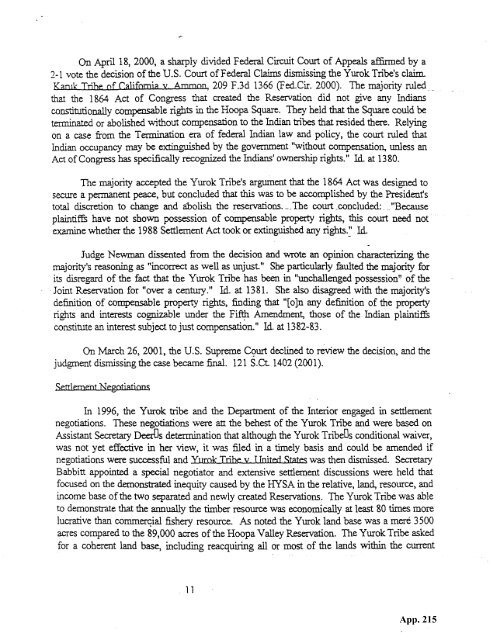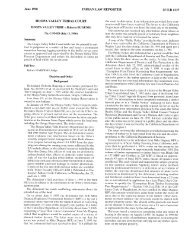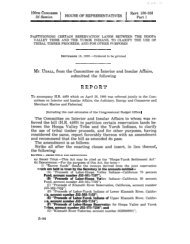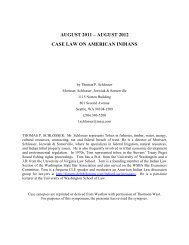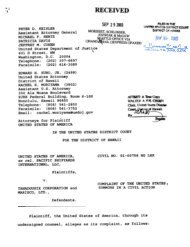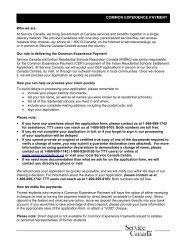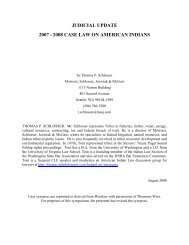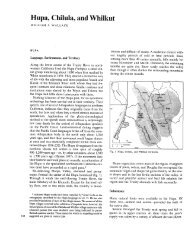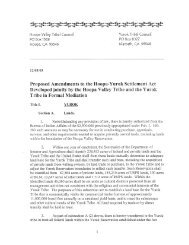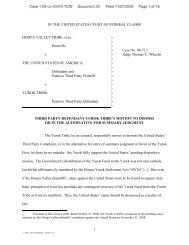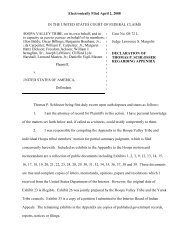Hoopa appendix supporting summary judgment - Schlosser Law Files
Hoopa appendix supporting summary judgment - Schlosser Law Files
Hoopa appendix supporting summary judgment - Schlosser Law Files
You also want an ePaper? Increase the reach of your titles
YUMPU automatically turns print PDFs into web optimized ePapers that Google loves.
On April 18, 2000, a sharply divided Federal Circuit Court of Appeals affirmed by a<br />
2-1 vote the decision of the U.S. Court ofFederal Claims dismissing the Yurok Tribe’s claim..<br />
Kanik Trihe of C~1ifnrni~v Ammcin, 209 F.3d 1366 (Fed.Cir. 2000). The majority ruled -<br />
that the 1864 Act of Congress that created the Reservation did not give any Indians<br />
constitutionally compensable rights in the <strong>Hoopa</strong> Square. They held that the Square could be<br />
terminated or abolished without compensation to the Indian tribes that resided there. Relying<br />
on a case from the Termination era of federal Indian law and policy, the court ruled that<br />
Indian occupancy may be extinguished by the government “without compensation, unless an<br />
Act of Congress has specifically recognized the Indians’ ownership tights.” Id. at 1380.<br />
The majority accepted the Yurok Tribe’s argument that the 1864 Act was designed to<br />
secure a permanent peace, but concluded that this was to be accomplished by the President’s<br />
total discretion to change and abolish the reservations. The court .concluded: “Because<br />
plainti~have not shown possession of compensable property rights, this court need not<br />
examine whether the 1988 Settlement Act took or extinguished any tights.” Id..<br />
Judge Newman dissented from the decision and wrote an opinion characterizing the<br />
majority’s reasoning as “incorrect as well as unjust” She particularly faulted the majority for<br />
its disregard of the fact that the Yurok Tribe has been in “unchallenged possession” of the<br />
• Joint Reservation for “over a century.” Id. at 1381. She also disagreed with the rnajorit~s<br />
definition of compensable property rights, finding that “[o)n any definition of the property<br />
rights and interests cognizable under the Fifth Amendment, those of the Indian plainti~<br />
constitute an interest subject tojust compensation.” Id. at 1382-83.<br />
On March 26, 2001, the U.S. Supreme Court declined to review the decision, and the<br />
<strong>judgment</strong> dismissing the case became final. 121 S.Ct. 1402 (2001).<br />
Seffi ernerit Negotiations<br />
In 1996, the Yurok tribe and the Department of the Interior engaged in. settlement<br />
negotiations. These negotiations were at the behest of the Yurok Tribe and were based on<br />
Assistant Secretary DeerOs determination that although the Yurok TribeOs conditional waiver,<br />
was not yet effective in her view, it was flied in. a timely basis and could be amended if<br />
negotiations were successful and Y~mkTribe v I Inited Ststec was then dismissed. Secretary<br />
Babbitt appointed a special negotiator and extensive settlement discussions were held that<br />
focused on the demonstrated inequity caused by the HYSA in the relative, land, resource, and<br />
income base ofthe two separated and newly created Reservations. The Yurok Tribe was able<br />
to demonstrate that the annually the timber resource was economically at least 80 times more<br />
lucrative than commercial fishery resource. As noted the Yurok land base was a mere 3500<br />
acres compared to the 89,000 acres ofthe <strong>Hoopa</strong> Valley Reservation. The Yurok Tribe asked<br />
for a coherent land base, including reacquiring all or most of the lands within the current<br />
11


